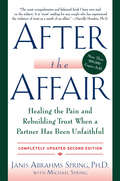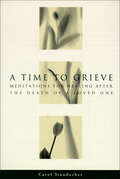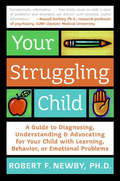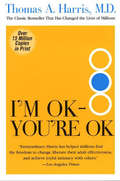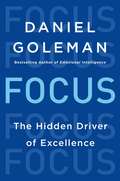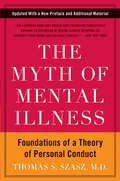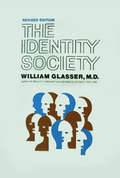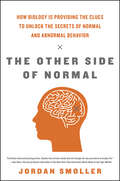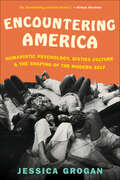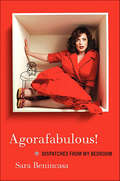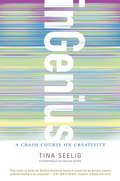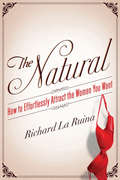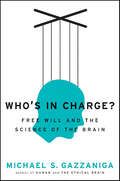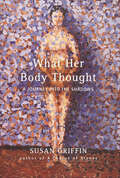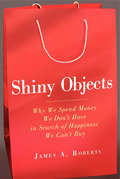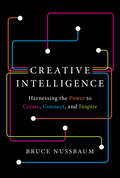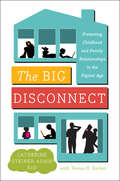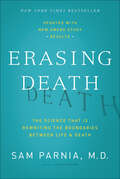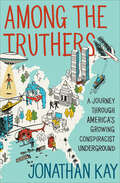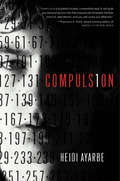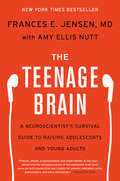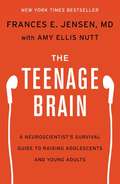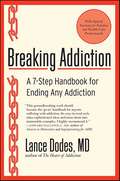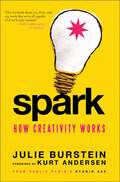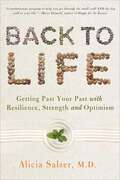- Table View
- List View
After the Affair
by Janis Abrahms Spring Michael SpringFor the 70 percent of couples who have been affected by extramarital affairs, this is the only book to offer proven strategies for surviving the crisis and rebuilding the relationship –– written by a nationally known therapist considered an expert on infidelity. When I was 15, I was raped. That was nothing compared to your affair. The rapist was a stranger; you, I thought, were my best friend. There is nothing quite like the pain and shock caused when a partner has been unfaithful. The hurt partner often experiences a profound loss of self–respect and falls into a depression that can last for years. For the relationship, infidelity is often a death blow. After the Affair is the first book to help readers survive this crisis. Written by a clinical psychologist who has been treating distressed couples for 22 years, it guides both hurt and unfaithful partners through the three stages of healing: Normalizing feelings, deciding whether to recommit and revitalizing the relationship. It provides proven, practical advice to help the couple change their behavior toward each other, cultivate trust and forgiveness and build a healthier, more conscious intimate partnership.
A Time to Grieve: Meditations for Healing After the Death of a Loved One
by Carol StaudacherA collection of truly comforting, down-to-earth thoughts and meditations -- including the authentic voices of survivors -- for anyone grieving the loss of a loved one.
Your Struggling Child: A Guide to Diagnosing, Understanding, and Advocating for Your Child with Learning, Behavior, or Emotional Problem
by Robert F. Newby Lynn SonbergHere is a practical, compassionate book parents can turn to when they first recognize that their child has a "problem" -- but aren't sure what it is or where to seek help. At this very moment, millions of children across the U.S. are falling behind in school, acting out impulsively at home, having problems making friends, suffering dramatic mood swings, and more. Their parents are frustrated and afraid, aware that something's wrong, but not sure where to turn for help or how to cope with their child's behavior. "Is it a learning disorder, ADHD, anxiety disorder, or some combination?" they wonder. "Are these moods and behaviors normal or abnormal? Will my child outgrow them?" This book by a noted neuropsychologist explains the different and overlapping symptoms of learning, mood, and behavior disorders and guides parents in getting the right diagnosis and treatment. Dr. Newby demystifies the process and empowers parents. Step by step, he explains: --How to observe and chart your child's behavior--a critical diagnostic tool --What to expect during the evaluation and treatment process --How to partner with medical and school professionals to assist your child and what to do when conflicts arise Clear and comprehensive, this supportive guide will be every parent's first line of defense in helping a troubled child.
I'm Ok, You're Ok
by Thomas HarrisTransactional Analysis delineates three observable ego-states (Parent, Adult, and Child) as the basis for the content and quality of interpersonal communication. "Happy childhood" notwithstanding, says Harris, most of us are living out the Not ok feelings of a defenseless child, dependent on ok others (parents) for stroking and caring. At some stage early in our lives we adopt a "position" about ourselves and others that determines how we feel about everything we do. And for a huge portion of the population, that position is "I'm Not OK -- You're OK." This negative "life position," shared by successful and unsuccessful people alike, contaminates our rational Adult capabilities, leaving us vulnerable to inappropriate emotional reactions of our Child and uncritically learned behavior programmed into our Parent. By exploring the structure of our personalities and understanding old decisions, Harris believes we can find the freedom to change our lives.
Focus: The Hidden Driver of Excellence
by Daniel GolemanThe author of the international bestseller Emotional Intelligence returns with a groundbreaking look at today's scarcest resource and the secret to high performance and fulfillment: attention. For more than two decades, psychologist and journalist Daniel Goleman has been scouting the leading edge of the human sciences for what's new, surprising, and important. In Focus, he delves into the science of attention in all its varieties, presenting a long-overdue discussion of this little-noticed and underrated mental asset that matters enormously for how we navigate life. Attention works much like a muscle: use it poorly and it can wither; work it well and it grows. In an era of unstoppable distractions, Goleman persuasively argues that now more than ever we must learn to sharpen focus if we are to contend with, let alone thrive in, a complex world. Goleman analyzes attention research as a threesome: inner, other, and outer focus. A well-lived life demands that we be nimble at each. Goleman shows why high-performers need all three kinds of focus, as demonstrated by rich case studies from fields as diverse as competitive sports, education, the arts, and business. Those who excel rely on what Goleman calls smart practice—such as mindfulness meditation, focused preparation and recovery from setbacks, continued attention to the learning curve, and positive emotions and connections—that help them improve habits, add new skills, and sustain excellence. Combining cutting-edge research with practical findings, Focus reveals what distinguishes experts from amateurs and stars from average performers. Ultimately, Focus calls upon readers not only to pay attention to what matters most to them personally, but also to turn their attention to the pressing problems of the wider world, to the powerless and the poor, and to the future, not just to the seductively simple demands of the here and now.
The Myth of Mental Illness
by Thomas S. Szasz50th Anniversary Edition With a New Preface and Two Bonus Essays The most influential critique of psychiatry ever written, Thomas Szasz's classic book revolutionized thinking about the nature of the psychiatric profession and the moral implications of its practices. By diagnosing unwanted behavior as mental illness, psychiatrists, Szasz argues, absolve individuals of responsibility for their actions and instead blame their alleged illness. He also critiques Freudian psychology as a pseudoscience and warns against the dangerous overreach of psychiatry into all aspects of modern life.
Identity Society
by William GlasserThis interesting societal study by the father of Reality Therapy presents a view that since survival is no longer the major issue for humans, development of self and identity is a normal social quest.
The Other Side of Normal: How Biology Is Providing the Clues to Unlock the Secrets of Normal and Abnormal Behavior
by Jordan SmollerPsychiatry has ignored the normal. The focus on defining abnormal behavior has obscured what turns out to be a more fundamental question—how does the biology of the brain give rise to the mind, which in turn gives rise to everything we care about: thoughts, feelings, desires, and relationships? In The Other Side of Normal, Harvard psychiatrist Jordan Smoller shows us that understanding what the mind was designed to do in the first place demystifies mental illness and builds a new foundation for defining psychiatric disorders—from autism to depression. Smoller argues there are no bright lines between normal and abnormal. Psychiatric disorders are variations of the same brain systems that evolved to help us solve the challenges of everyday life. How do we become who we are? Smoller explains where our personalities come from, and how the temperaments we had as infants actually stay with us into adulthood. Why do we choose to date, love, and marry the people we do? Why do some of us form healthy relationships while others form unstable ones? Our relationships are shaped by the biology that drives two imperatives: maternal-child bonding and child-parent attachment. Along the way, Smoller tackles an even greater question—what do we mean by "normal"?—as he explores the puzzles behind the epidemics of multiple personalities and koro, the shocking phobia that one's penis is shrinking. He also looks at the controversial history of psychiatric classification and the explosive debates over how much early experiences influence our minds and to what degree genetics affect our temperaments, personalities, and emotional lives. Throughout this examination, Smoller explores the hidden sides of such questions as: How are trust and love rooted in biology? How much does sexual attraction stem from biology rather than culture? And what can the scientific study of normal behavior tell us about what it means to be human?Based on the author's groundbreaking research and personal experiences treating psychological disorders, The Other Side of Normal changes the way we think about the human condition.
Encountering America: Humanistic Psychology, Sixties Culture & the Shaping of the Modern Self
by Jessica GroganA dramatic narrative history of the psychological movement that reshaped American cultureThe expectation that our careers and personal lives should be expressions of our authentic selves, the belief that our relationships should be defined by openness and understanding, the idea that therapy can help us reach our fullest potential—these ideas have become so familiar that it's impossible to imagine our world without them.In Encountering America, cultural historian Jessica Grogan reveals how these ideas stormed the barricades of our culture through the humanistic psychology movement—the work of a handful of maverick psychologists who revolutionized American culture in the 1960s and '70s. Profiling thought leaders including Abraham Maslow, Rollo May, and Timothy Leary, Grogan draws on untapped primary sources to explore how these minds and the changing cultural atmosphere combined to create a widely influential movement. From the group of ideas that became known as New Age to perennial American anxieties about wellness, identity, and purpose, Grogan traces how humanistic psychology continues to define the way we understand ourselves.
Agorafabulous!: Dispatches from My Bedroom
by Sara Benincasa“Sara Benincasa is one of the funniest writers I know—and I know a disturbing number of them. She is also one of the most honest.”—Sam Apple, author of American Parent and editor-in-chief of The Faster Times “Sara is extremely funny and should have many books out so we can all read them and laugh.” —Margaret ChoComedian, writer, blogger, radio and podcast host, and YouTube sensation, Sara Benincasa bravely and outrageously brings us “Dispatches from My Bedroom” with Agorafabulous! One of the funniest and most poignant books ever written about a mental illness, Agorafabulous! is a hilarious, raw, and unforgettable account of how a terrified young woman, literally trapped by her own imagination, evolved into a (relatively) high-functioning professional smartass. Down to earth and seriously funny, Benincasa’s no-holds-barred revelations offer readers the politically incorrect hilarity they heartily crave, yet is so often missing from your typical, weepy, and redemptive personal memoir.
inGenius
by Tina SeeligInternationally bestselling author and award-winning Stanford University educator Tina Seelig has taught creativity to the best and brightest students at Stanford and to business leaders around the world. With inGenius she expertly decodes creativity, revealing an approach that everyone can use to enhance their own creative genius. In today's world, innovation and creative problem solving are more important than ever to succeed. For many of us, however, this process is a mystery. Whether we are attempting to generate fresh ideas or struggling with problems with no solutions in sight, the innovative spark is out of reach. inGenius offers a revolutionary new model, the Innovation Engine, which explains how creativity is generated on the inside and how it is influenced by the outside world. Describing the variables that work together to catalyze or inhibit our creative abilities, Seelig provides a set of tools we can each use right away to radically enhance our own ingenuity as well as that of our colleagues, teams, organizations, and communities. Seelig's groundbreaking work reveals that creativity is an endless renewable resource we can tap into at any time. It is as natural as breathing, and just as necessary for leading a successful and fulfilling life.
The Natural
by Richard La RuinaRichard La Ruina used to be the guy who couldn't get the girl. Shy, painfully awkward, and still living at home with his mother, at twenty-five he decided to finally take control of his life and become the kind of man men admire and women desire. Today, La Ruina is one of the world's best-known pickup artists, someone who can confidently approach and attract any woman. La Ruina, as founder of PUA Training (Pickup Artist Training), has personally coached thousands of men through their own dramatic transformations. In The Natural, he brings that experience to you, delivering field-tested methods and easy-to-use tools for attracting the women you want. Just like riding a bike or driving a car, meeting women and making them fall for you is a learned skill that, with enough practice, becomes effortless. There's no need for tricks, gimmicks, or lies. Instead, these methods make you more confident and therefore more attractive to women. Using the tools in The Natural, you'll finally feel comfortable in your own skin and have the ability to attract women just by being yourself. From body language to conversation starters, eye contact to the first touch, The Natural is a step-by-step blueprint for being the guy women can't resist.
Who's in Charge?: Free Will and the Science of the Brain
by Michael S. Gazzaniga“Big questions are Gazzaniga’s stock in trade.”—New York Times“Gazzaniga is one of the most brilliant experimental neuroscientists in the world.”—Tom Wolfe“Gazzaniga stands as a giant among neuroscientists, for both the quality of his research and his ability to communicate it to a general public with infectious enthusiasm.”—Robert Bazell, Chief Science Correspondent, NBC News The author of Human, Michael S. Gazzaniga has been called the “father of cognitive neuroscience.” In his remarkable book, Who’s in Charge?, he makes a powerful and provocative argument that counters the common wisdom that our lives are wholly determined by physical processes we cannot control. His well-reasoned case against the idea that we live in a “determined” world is fascinating and liberating, solidifying his place among the likes of Oliver Sacks, Antonio Damasio, V.S. Ramachandran, and other bestselling science authors exploring the mysteries of the human brain.
What Her Body Thought: A Journey Into the Shadows
by Susan GriffinIn this boldly intimate and intelligent blend of personal memoir, social history, and cultural criticism, Susan Griffin profoundly illuminates our understanding of illness. She explores its physical, emotional, spiritual, and social aspects, revealing how it magnifies our yearning for connection and reconciliation.Griffin begins with a gripping account of her own harrowing experiences with Chronic Fatigue and Immune Dysfunction Syndrome (CFIDS), a potentially life-threatening illness that has been misconstrued and marginalized through the label "psychosomatic." Faced with terrifying bouts of fatigue, pain, and diminished thinking, the shame of illness, and the difficulty of being told you are "not really ill," she was driven to understand how early childhood loss made her susceptible to disease.Alongside her own story, Griffin weaves in her fascinating interpretation of the story of Marie du Plessis, popularized as the fictional Camille, an eighteenth-century courtesan whose young life was taken by tuberculosis. In the old story, Griffin finds contemporary themes of "money, bills, creditors, class, social standing, who is acceptable and who not, who is to be protected and who abandoned." In our current economy, she sees "how to be sick can impoverish, how poverty increases the misery of sickness, and how the implicit violence of this process wounds the soul as well as the body."Griffin insists that we must tell our stories to maintain our own integrity and authority, so that the sources of suffering become visible and validated. She writes passionately of a society where we are all cared for through "the rootedness of our connections. How the wound of being allowed to suffer points to a need to meet at the deepest level, to make an exchange at the nadir of life and death, the giving and taking which will weave a more spacious fabric of existence, communitas, community." Her views of the larger problems of illness and society are deeply illuminating.
Shiny Objects
by James A. RobertsAmericans toss out 140 million cell phones every year. We discard 2 million plastic bottles every five minutes. And our total credit-card debt as of July 2011 is $793 billion. Plus, credit cards can make you fat. The American Dream was founded on the belief that anyone dedicated to thrift and hard work could create opportunities and achieve a better life. Now that dream has been reduced to a hyperquantified desire for fancier clothes, sleeker cars, and larger homes. We've lost our way, but James Roberts argues that it's not too late to find it again. In Shiny Objects, he offers us an opportunity to examine our day-to-day habits, and once again strive for lives of quality over quantity. Mining his years of research into the psychology of consumer behavior, Roberts gets to the heart of the often-surprising ways we make our purchasing decisions. What he and other researchers in his field have found is that no matter what our income level, Americans believe that we need more to live a good life. But as our standard of living has climbed over the past forty years, our self-reported "happiness levels" have flatlined. Roberts isn't merely concerned with the GDP or big-ticket purchases-damaging spending habits play out countless times a day, in ways big and small: he demonstrates that even the amount we spend at our favorite fast-food joint increases anywhere from 60 to 100 percent when we use a credit card instead of cash. Every time we watch TV or turn on a radio we're exposed to marketing messages (experts estimate up to 3,000 of them daily). Consumption is king, and its toll is not just a financial one: relationships are suffering, too, as materialism encroaches on the time and value we give the people around us. By shedding much-needed light on the science of spending, Roberts empowers readers to make smart changes, improve self-control, and curtail spending. The American Dream is still ours for the taking, and Shiny Objects is ultimately a hopeful statement about the power we each hold to redefine the pursuit of happiness.
Creative Intelligence: Harnessing the Power to Create, Connect, and Inspire
by Bruce NussbaumOffering insights from the spheres of anthropology, psychology, education, design, and business, Creative Intelligence by Bruce Nussbaum, a leading thinker, commentator, and curator on the subjects of design, creativity, and innovation, is first book to identify and explore creative intelligence as a new form of cultural literacy and as a powerful method for problem-solving, driving innovation, and sparking start-up capitalism.Nussbaum investigates the ways in which individuals, corporations, and nations are boosting their creative intelligence — CQ—and how that translates into their abilities to make new products and solve new problems. Ultimately, Creative Intelligence shows how to frame problems in new ways and devise solutions that are original and highly social. Smart and eye opening, Creative Intelligence: Harnessing the Power to Create, Connect, and Inspire illustrates how to connect our creative output with a new type of economic system, Indie Capitalism, where creativity is the source of value, where entrepreneurs drive growth, and where social networks are the building blocks of the economy.
The Big Disconnect
by Teresa H. Barker Edd Catherine Steiner-AdairHave iPads replaced conversation at the dinner table? What do infants observe when their parents are on their smartphones? Should you be your childs Facebook friend?As the focus of family has turned to the glow of the screen--children constantly texting their friends, parents working online around the clock--everyday life is undergoing a massive transformation. Easy availability to the Internet and social media has erased the boundaries that protect children from the unsavory aspects of adult life. Parents often feel they are losing a meaningful connection with their children. Children are feeling lonely and alienated. The digital world is here to stay, but what are families losing with technologys gain?As renowned clinical psychologist Catherine Steiner-Adair explains, families are in crisis around this issue, and even more so than they realize. Not only do chronic tech distractions have deep and lasting effects, but children desperately need parents to provide what tech cannot: close, significant interactions with the adults in their lives. Drawing on real-life stories from her clinical work with children and parents, and her consulting work with educators and experts across the country, Steiner-Adair offers insights and advice that can help parents achieve greater under-standing, authority, and confidence as they come up against the tech revolution unfolding in their living rooms. We all know that deep connection with the people we love means everything to us. Its time to look with fresh eyes and an open mind at the disconnection we are experiencing from our extreme device dependence. Its never too late to put down the iPad and come to the dinner table.
Erasing Death: The Science That Is Rewriting the Boundaries Between Life & Death
by Sam Parnia Josh YoungErasing Death: The Science That Is Rewriting the Boundaries Between Life and Death reveals that death is not a moment in time. Death, rather, is a process—a process that can be interrupted well after it has begun. Innovative techniques have proven to be effective in revitalizing both the body and mind, but they are only employed in approximately half of the hospitals throughout the United States and Europe. Dr. Sam Parnia, Director of the AWARE Study (AWAreness during REsuscitation) and one of the world’s leading experts on the scientific study of death and near-death experiences (NDE), presents cutting-edge research from the front lines of critical care and resuscitation medicine while also shedding light on the ultimate mystery: What happens to human consciousness during and after death? Dr. Parnia reveals how some form of “afterlife” may be uniquely ours, as evidenced by the continuation of the human mind and psyche after the brain stops functioning. With physicians such as Dr. Parnia at the forefront, we are on the verge of discovering a new universal science of consciousness that reveals the nature of mind and a future where death is not the final defeat, but is, in fact, reversible.
Among the Truthers: A Journey Through America's Growing Conspiracist Underground
by Jonathan KayFrom 9/11 conspiracy theorists and UFO obsessives tothe cult of Ayn Rand and Birthercrusaders, America is suffering from an explosion in post-rationalistideological movements. In Among the Truthers,journalist Jonathan Kay offers a thoughtful and sobering look at how socialnetworking and Web-based video sharing have engendered a flourishing of new conspiracism. Kay details the sociological profiles of tenbrands of modern conspiracists—the Failed Historian,the Mid-Life Crack-Up, the Damaged Survivor, the Campus Revolutionary, theStoner, the Clinical Case, the Puzzle Solver, the Christian Doomsayer, the CosmicVoyager, and the Egomaniac—in a compelling exploration of America’s departurefrom reason and what it means for the very future of rational discourse as thenation steps further into the 21st century.
Compulsion
by Heidi Ayarbe<P>Today has to be perfect. <br>Magic. <br>I look at the clock. <br>10:14 AM. <P>Ten fourteen. One plus one is two plus four is six plus ten is sixteen minus one is fifteen minus two is thirteen. OK. <P>I turn from the clock and walk into the hallway. "Ready." <P>Saturday will be the third state soccer championship in a row for Jake Martin. Three. A good number. Prime. With Jake on the field, Carson City High can't lose because Jake has the magic: a self-created protection generated by his obsession with prime numbers. It's the magic that has every top soccer university recruiting Jake, the magic that keeps his family safe, and the magic that suppresses his anxiety attacks. But the magic is Jake's prison, because sustaining it means his compulsions take over nearly every aspect of his life. <P>Jake's convinced the magic will be permanent after Saturday, the perfect day, when every prime has converged. Once the game is over, he won't have to rely on his sister to concoct excuses for his odd rituals. His dad will stop treating him like he is some freak. Maybe he'll even make a friend other than Luc. <P>But what if the magic doesn't stay? <P>What if the numbers never leave? <P>Acclaimed author Heidi Ayarbe has created an honest and riveting portrait of a teen struggling with obsessive compulsive disorder in this breathtaking and courageous novel.
The Teenage Brain: A Neuroscientist's Survival Guide to Raising Adolescents and Young Adults
by Frances E. Jensen Amy Ellis NuttDrawing on her research, knowledge, and clinical experience, internationally respected neurologist--and mother of two boys--Frances E. Jensen, MD, offers a revolutionary look at the adolescent brain, providing remarkable insights that translate into practical advice both for parents and teenagers.Driven by the assumption that brain growth was almost complete by the time a child reached puberty, scientists believed for many years that the adolescent brain was essentially an adult one--only with fewer miles on it. Over the last decade, however, neurology and neuroscience have revealed that the teen years encompass vitally important stages of brain development.Motivated by her experience of parenting two teenagers, renowned neurologist Frances E. Jensen, MD, gathers what we've discovered about adolescent brain functioning and wiring, and in this groundbreaking, accessible book, explains how these eye-opening findings not only dispel commonly held myths about teens but also yield practical suggestions for adults and teenagers negotiating the mysterious and magical world of adolescent biology.Interweaving clear summary and analysis of research data with anecdotes drawn from her years as a clinician, researcher, and public speaker, Dr. Jensen explores adolescent brain functioning and development in the context of learning and multitasking, stress and memory, sleep, addiction, and decision making. Examining data connecting substance use to lingering memory issues and, sometimes, a lower adult IQ, The Teenage Brain explains why teenagers are not as resilient to the effects of drugs as we previously thought; reveals how multitasking impacts learning ability and concentration; and examines the consequences of stress on mental health during and beyond adolescence.Rigorous yet accessible, warm yet direct, The Teenage Brain sheds new light on the brains--and behaviors--of adolescents and young adults, and analyzes this knowledge to share specific ways in which parents, educators, and even the legal system can help them navigate their way more smoothly into adulthood in our ever challenging world.
The Teenage Brain: A Neuroscientist's Survival Guide To Raising Adolescents And Young Adults
by Frances E. Jensen Amy Ellis NuttNew York Times Bestseller<P><P> Drawing on her research knowledge and clinical experience, internationally respected neurologist—and mother of two boys—Frances E. Jensen, M.D., offers a revolutionary look at the science of the adolescent brain, providing remarkable insights that translate into practical advice for both parents and teenagers.<P> Driven by the assumption that brain growth was pretty much complete by the time a child began kindergarten, scientists believed for years that the adolescent brain was essentially an adult one—only with fewer miles on it. Over the last decade, however, the scientific community has learned that the teen years encompass vitally important stages of brain development.<P> Motivated by her personal experience of parenting two teenage boys, renowned neurologist Dr. Frances E. Jensen gathers what we’ve discovered about adolescent brain functioning, wiring, and capacity and, in this groundbreaking, accessible book, explains how these eye-opening findings not only dispel commonly held myths about the teenage years, but also yield practical suggestions that will help adults and teenagers negotiate the mysterious world of adolescent neurobiology.<P> Interweaving clear summary and analysis of research data with anecdotes drawn from her years as a parent, clinician, and public speaker, Dr. Jensen explores adolescent brain functioning and development in the contexts of learning and multitasking, stress and memory, sleep, addiction, and decision-making.<P> Rigorous yet accessible, warm yet direct, The Teenage Brain sheds new light on the brains—and behaviors—of adolescents and young adults, and analyzes this knowledge to share specific ways in which parents, educators, and even the legal system can help them navigate their way more smoothly into adulthood.
Breaking Addiction: A 7-Step Handbook for Ending Any Addiction
by Lance Dodes“Dr. Dodes’s approach runs directly counter to the paralyzing, but standard, message of ‘powerlessness’—a message that reinforces the sense of helplessness that is at the root of addicts’ life predicaments! Many psychiatrists recognize that this is where we must head, but Dr. Dodes is one with the guts to shine a beacon in the right direction.”—Stanton Peele, PhD, author of 7 Tools to Beat Addiction and The Life Process Program of TreatmentThe follow-up to his groundbreaking volume The Heart of Addiction, Dr. Lance Dodes’s Breaking Addiction is a step-by-step guide to beating addiction of any kind—from drugs and gambling to alcoholism, overeating, and sex addiction. By recognizing and understanding the emotional forces underlying addictive behaviors, Dr. Dodes says any dangerous, life-destroying obsession can be overcome. Including special bonus sections for both families and health-care professionals, Breaking Addiction is the new handbook for those suffering from addiction—a valuable resource that addresses addiction’s root causes and serves as an alternative to Alcoholics Anonymous and similar recovery programs.
Spark: How Creativity Works
by Kurt Andersen Julie Burstein“This is a book about joy, drive and art, work that we’re all capable of if we’ll only commit.” —Seth Godin, author of LinchpinPublic Radio International’s Julie Burstein, creator of the award-winning program Studio 360, along with its host Kurt Andersen, offers a rare, fascinating glimpse into some of the 21st century's greatest creative minds—from Yo-Yo Ma and Robert Plant to Mira Nair and Chuck Close, to David Milch and Joyce Carol Oates, to Rosanne Cash and beyond. Fans of Malcolm Gladwell’s Outliers, Daniel Pink’s A Whole New Mind, Rosamund Zander’s The Art of Possibility, and Lynda Barry’s What It Is will be enthralled and electrified by this unique look at the creative process of the world’s most talented and prolific artists.
Back to Life: Getting Past Your Past with Resilience, Strength, and Optimism
by Alicia SalzerBack to Life is a feel-good approach to overcoming that lets you try on the skills of the heroes you most admire. From icons of survival like Rosa Parks and Nelson Mandela to contemporary heroes like Michael J. Fox and Elizabeth Edwards, this book allows you to see what resilient survivors actually do when they feel lousy.This is a revolutionary approach to feeling better, rooted in the science of positive psychology and resilience theory, and would help anyone get a dose of soul food into their emotional diet; but these techniques are specially tailored to those trying to overcome traumas big and small—from Big-T Traumas, such as combat, abuse, and bereavement, to challenges one might think of as little-t traumas, like breakups, betrayals, job loss, health problems, and financial hardships. After years of working in the trenches of psychiatry, it became clear to Dr. Alicia Salzer that we needed some new methods to help people overcome, since the old methods often proved too painful for many to bear. It's all about being in the present and focusing on the future—no retelling and revisiting the past, no opening Pandora's box, no picking at old scabs. Back to Life is a creative and empowering way to learn the habits of resilient survivors while getting to know what you stand for, what makes you happy, and what emotions you need in your diet in order to thrive. In this book you will create a "holistic pillbox" of ten stones—each symbolizing a healthy new way of coping—that you can utilize when your past rears its head.The truth is, there have always been people in our midst who remain positive and passionate despite enormous challenges while others just get stuck. This is the secret playbook of those people, and it's full of accessible and fun exercises to help you try on the rose-colored glasses of those survivors we so admire.
